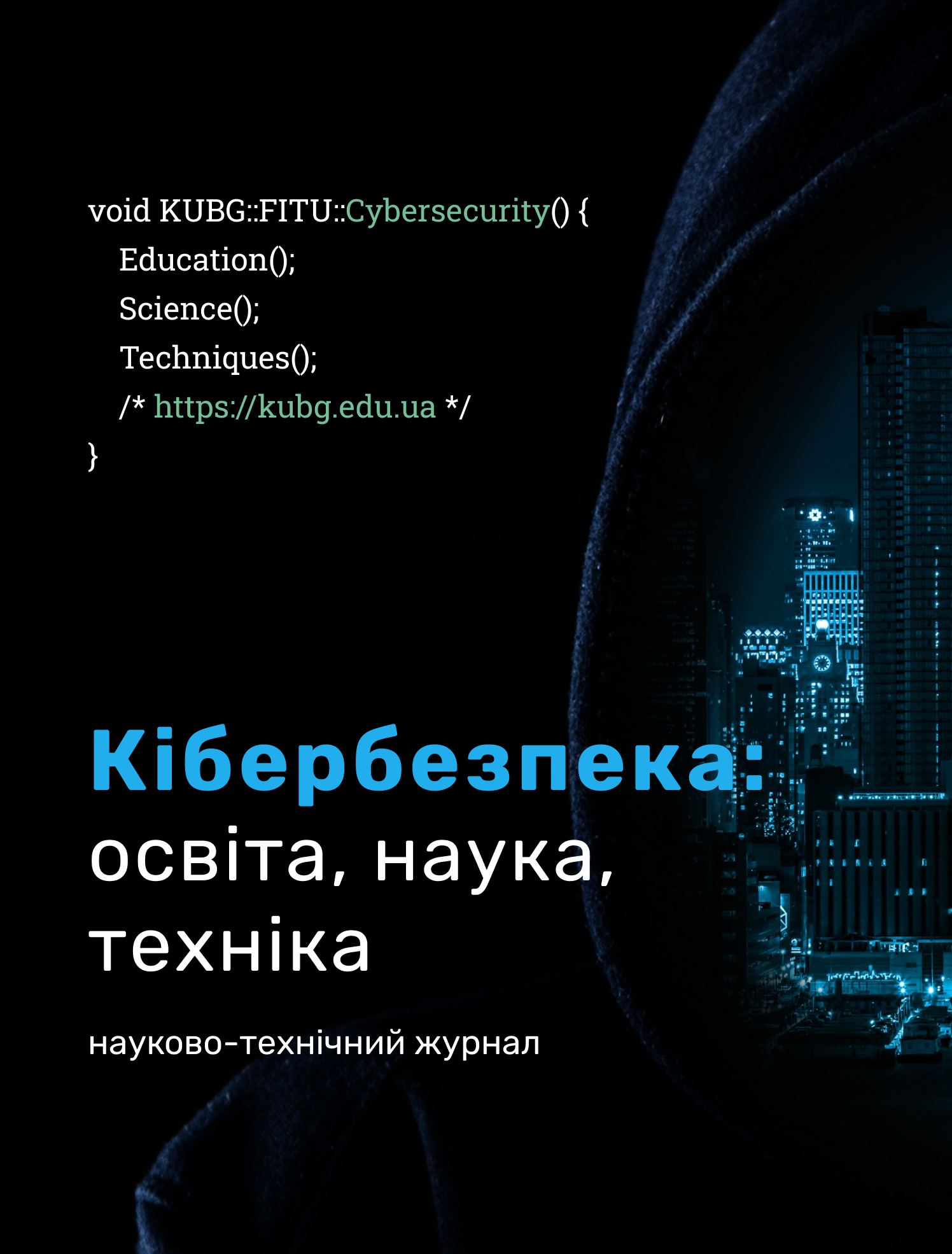МЕТОДИКА МІНІМІЗАЦІЇ ВИТРАТ НА ПОБУДОВУ БАГАТОКОНТУРНОЇ СИСТЕМИ ЗАХИСТУ НА ОСНОВІ ГЕНЕТИЧНОГО АЛГОРИТМУ
DOI:
https://doi.org/10.28925/2663-4023.2021.13.1628Ключові слова:
захист інформації; кібербезпека; контури захисту, багатокритеріальна оптимізація; генетичний алгоритмАнотація
У статті викладена методика багатокритеріальної оптимізації витрат на систему захисту інформації об'єкта інформатизації. Методика базується на застосуванні модифікованого генетичного алгоритму VEGA. Запропоновано модифікований алгоритм рішення задачі БКО параметрів багатоконтурною системи захисту інформації об'єкта інформатизації, який дозволяє обґрунтовувати оптимальні параметри компонентів СЗІ з урахуванням обраних експертом пріоритетних метрик кібербезпеки ОБІ. На відміну від існуючого класичного алгоритму VEGA, в модифікованому алгоритмі додатково застосовані принцип Парето, а також новий механізм селекції примірників популяції.
Принцип Парето застосовується для кращої точки. У цій точці рішення, трактуються як найкращі, якщо за однією з метрик кібербезпеки є поліпшення, а по інший метриці (або метриках) буде відповідно не гірше. Новий механізм селекції на відміну від традиційної, передбачає створення проміжної популяції. Формування проміжної популяції відбувається в кілька етапів. На першому етапі перша половина популяції формується на основі метрики - частка вразливостей об'єкта інформатизації, які усунуті в установлені терміни. На другому етапі друга половина проміжної популяції формується на основі метрики - частка ризиків, які неприпустимі для інформаційних активів об'єкта інформатизації. Далі ці частини проміжної популяції змішуються. Після змішування формується масив номерів і виробляється змішування. На заключному етапі селекції для схрещування будуть братися екземпляри (індивіди) за номером з цього масиву. Номери вибираються випадково. Ефективність застосування даної методики підтверджена практичними результатами
Завантаження
Посилання
Okutan, A., Yang, S. J., McConky, K., & Werner, G. (2019). CAPTURE: Cyberattack Forecasting Using Non-Stationary Features with Time Lags. In 2019 IEEE Conference on Communications and Network Security (CNS) (pp. 205–213). IEEE.
Barreto, C., & Koutsoukos, X. (2019, October). Design of Load Forecast Systems Resilient Against Cyber-Attacks. In International Conference on Decision and Game Theory for Security (pp. 1–20). Springer, Cham.
Chandra, Y., & Mishra, P. K. (2019). Design of cyber warfare testbed. In Software Engineering (pp. 249–256). Springer, Singapore.
Sándor, H., Genge, B., Szántó, Z., Márton, L., & Haller, P. (2019). Cyber attack detection and mitigation: Software Defined Survivable Industrial Control Systems. International Journal of Critical Infrastructure Protection, 25, pp. 152–168.
Chiba, Z., Abghour, N., Moussaid, K., El Omri, A., & Rida, M. (2019). New Anomaly Network Intrusion Detection System in Cloud Environment Based on Optimized Back Propagation Neural Network Using Improved Genetic Algorithm. International Journal of Communication Networks and Information Security, 11(1), 61–84.
Nozaki, Y., & Yoshikawa, M. (2019). Security evaluation of ring oscillator puf against genetic algorithm based modeling attack. In International Conference on Innovative Mobile and Internet Services in Ubiquitous Computing (pp. 338–347). Springer, Cham.
Dwivedi, S., Vardhan, M., & Tripathi, S. (2020). Incorporating evolutionary computation for securing wireless network against cyberthreats. The Journal of Supercomputing, 1–38.
Zhang, F., Kodituwakku, H. A. D. E., Hines, J. W., & Coble, J. (2019). Multilayer Data-Driven Cyber-Attack Detection System for Industrial Control Systems Based on Network, System, and Process Data. IEEE Transactions on Industrial Informatics, 15(7), 4362–4369.
Sureshkumar, T., Anand, B., & Premkumar, T. (2019). Efficient Non-Dominated Multi-Objective Genetic Algorithm (NDMGA) and network security policy enforcement for Policy Space Analysis (PSA). Computer Communications, 138, 90–97.
Shang, Q., Chen, L., Wang, D., Tong, R., & Peng, P. (2019). Evolvable Hardware Design of Digital Circuits Based on Adaptive Genetic Algorithm. In International Conference on Applications and Techniques in Cyber Security and Intelligence (pp. 791–800). Springer, Cham.
Yang, Y. (2019). Research on Hybrid Quantum Genetic Algorithm Based on Cross-Docking Delivery Vehicle Scheduling. In The International Conference on Cyber Security Intelligence and Analytics (pp. 893–900). Springer, Cham.
Saenko, I., & Kotenko, I. (2019). A role-base approach and a genetic algorithm for VLAN design in large critical infrastructures. In Proceedings of the Genetic and Evolutionary Computation Conference Companion (pp. 1643–1650).
Aleksieva, Y., Valchanov, H., & Aleksieva, V. (2019). An approach for host based botnet detection system. In 2019 16th Conference on Electrical Machines, Drives and Power Systems (ELMA) (pp. 1–4). IEEE.
Vinayakumar, R., Alazab, M., Soman, K. P., Poornachandran, P., Al-Nemrat, A., & Venkatraman, S. (2019). Deep learning approach for intelligent intrusion detection system. IEEE Access, 7, 41525–41550.
Malarvizhi, N., Selvarani, P., & Raj, P. (2019). Adaptive fuzzy genetic algorithm for multi biometric authentication. Multimedia Tools and Applications, 1–14.
Alhijawi, B., Kilani, Y., & Alsarhan, A. (2020). Improving recommendation quality and performance of genetic-based recommender system. International Journal of Advanced Intelligence Paradigms, 15(1), 77–88.
Baroudi, U., Bin-Yahya, M., Alshammari, M., & Yaqoub, U. (2019). Ticket-based QoS routing optimization using genetic algorithm for WSN applications in smart grid. Journal of Ambient Intelligence and Humanized Computing, 10(4), 1325–1338.
Llansó, T., McNeil, M., & Noteboom, C. (2019). Multi-Criteria Selection of Capability-Based Cybersecurity Solutions. In Proceedings of the 52nd Hawaii International Conference on System Sciences, pp. 7322–7330.
Kong, T., Wang, L., Ma, D., Xu, Z., Yang, Q., & Chen, K. (2019). A Secure Container Deployment Strategy by Genetic Algorithm to Defend against Co-Resident Attacks in Cloud Computing. In 2019 IEEE 21st International Conference on High Performance Computing and Communications; IEEE 17th International Conference on Smart City; IEEE 5th International Conference on Data Science and Systems (HPCC/SmartCity/DSS) (pp. 1825–1832). IEEE.
Lakshmanaprabu, S. K., Mohanty, S. N., Krishnamoorthy, S., Uthayakumar, J., & Shankar, K. (2019). Online clinical decision support system using optimal deep neural networks. Applied Soft Computing, 81, 105487.
Lakhno, V., Akhmetov, B., Adilzhanova, S., Blozva, A., Svitlana, R., Dmytro, R. The use of a genetic algorithm in the problem of distribution of information security organizational and financial resources (2020) ATIT 2020 - Proceedings: 2020 2nd IEEE International Conference on Advanced Trends in Information Theory, № 9349310, pp. 251-254.
Опубліковано
Як цитувати
Номер
Розділ
Ліцензія

Ця робота ліцензується відповідно до Creative Commons Attribution-NonCommercial-ShareAlike 4.0 International License.




